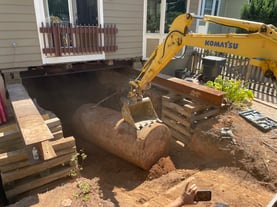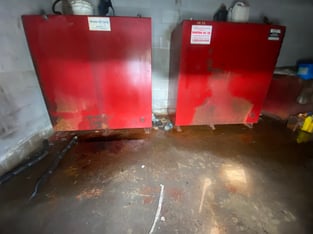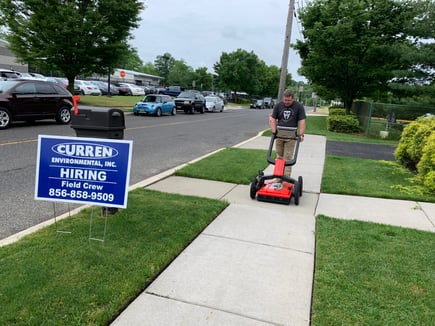Environmental consultants can be like good bartenders; people view us as impartial and as a shoulder to cry on. Over 20 years in business with tens of thousands of projects relating to real estate transactions we get an earful from buyers, sellers, realtors, inspectors, mortgage companies, attorneys, etc. Here are some tidbits of knowledge from the environmental fly on the wall during the real estate transaction.
Technically every real estate transaction starts as an "as is" transaction. The seller is selling the property "as is", as they are not offering to do anything to the property when it is first listed for sale to prospective buyers. That is the foundation of the real estate listed for sale. Of course, some properties have "as is" listed in the sales description. These "as is" sites are typically bank-owned, estate sales, or owned by entities that did not maintain the dwelling for various reasons. They want it known that repairs should not be anticipated, nor negotiated.
Due Diligence.
A property will fall out of the "as is" category shortly after it goes under contract and the buyer completes their due diligence. Due diligence is comprised of the many experts the buyer retains to evaluate the property for issues (Home Inspector, Environmental Engineer for structure, radon, mold, septic, roofing, tank sweep, etc.). A typical buyer anticipates a property being livable and in good repair, this is akin to owning a car, when your car has something broken it is noticeable and gets addressed. In a home, if an outlet or hose bib not working you will likely just work around it.
Cracks in a foundation, mold in the crawlspace, a basement that gets water on occasion, an exhaust fan that blows moist air in the attic, you can still live in the home so why, as a seller would you bother spending money to fix it? It does not affect your (the seller's) quality of life. Curren often sees this common seller's point of view. The rub is a buyer who does not see it through rose-colored glasses and is not looking to live with these issues when they evaluate a property. They are looking for the appropriate number of bedrooms, storage space, yard, kitchen, neighborhood, school system, etc., many things that just go along with the location of the home and features that they want to check off on their "want" list. Buyers, and rightfully so, view the list of repair items as adding to their overall cost of buying the home (assuming they undertake the repairs) which is not appealing. Long story short, sellers should expect a list of repair items even if the property is being sold "as is", but often sellers do not as they likely came down off their original sales price for the buyer.
Going Under Contract of Sale
Going under contract of sale is a short-term high-stress relationship between buyers and sellers with a high dollar asset one party does not want to overpay for and one doesn’t want to sell below market value. As with any relationship, things can sour so how and what you expect to happen needs to be understood and palatable to both parties, compromise is a good thing.
Management of expectations, buyers, and sellers
Buyer- A buyer is buying a home at an agreed-upon price until inspections reveal repair items and deficiencies in a home. Any repair adds to their purchase price unless the buyer factored in money for repairs when making their offer for the property. In short, the buyer is highly likely to have a list of repairs for the seller after inspections.
What about an"As Is" Sale?
Much to the chagrin of a seller with an As Is Sale, buyers do not agree with taking it or leaving it. Buyers will ask for concessions after the buyer finds repair items. Depending on the contract of sale, the two parties can negotiate monies for repairs or call off the transaction, with each party walking away. The seller is walking away with knowledge of deficiencies that they and their realtor, attorney have an obligation to disclose to future sellers. The seller will also understand that these deficiencies may be requested to be addressed by another buyer. Often you will find these properties sitting for lengths of time, incurring costs and frustration for the sellers. Not 100% of the time, but more times than you would expect, eventually sellers will concede something for known issues as doing nothing has their costs.
New Home Purchase
Completing inspections on a new home gets you the most bang for your buck because it is a safe bet that you will get your entire to-do list completed as the home is under warranty. Even in new construction the builder and subs may miss something, that is why you get a warranty. So, inspect away and get your repairs made.
Preexisting Home Sale
Now you are buying a nonnew home, call it a previously owned, used, preexisting home, whatever the term, you are not buying new, so expect the home to not be 100% tip-top shape. Your realtor should prep you that the older home with charm on the mature tree-lined street will have items funded from inspections, maybe 20 items. Do not expect these 20 items to be enthusiastically addressed by the seller when presented. Some the owner may be aware of and has deferred repair to previously, some may be new, and not all will be fixed for sure. The owner knows their home is habitable (roof does not leak, toilets flush,) so asking for repairs or monies for repairs may seem out of line for the seller. Bear in mind the seller is not moving because the dwelling is falling apart, they have other driving motivations for the sale. So, when the owner gets a 65-page report with a list of 20 issues with their home, well expect the seller to be a little taken back, slightly offended, etc. Of course, the home inspection whammy is something sellers should be prepared for by their realtor but rarely are prepared for. I have seen sellers take equal offense from a 16-page report as a 60-page report, the bottom line no one likes criticism.
Tip on requesting home repairs in a real estate transaction aka Where do buyers fail in buying a home?
Home buying due diligence will invariably find items requiring correction. Inspectors will find multiple issues with the home you are buying. The buyer sees dollar signs over and above the long-term loan commitment they are signing to purchase the home. Understand as a buyer, the longer the repair list you find the more likely the owner did not know about every issue detected. So, when you think about what you want repaired, think of yourself as the seller. At what point would you start getting frustrated with the requests requested? Remember you are buying a used home (read older home) you should be aware that there will be issues, what you are willing to accept is part of the negotiation and will affect how smoothly the transaction progresses.
Where do sellers fail in selling a home?
First having an experienced realtor is priceless, even more so for an attorney in the real estate transaction. So, selling a home means you need a professional team backing you up. Regardless of how many homes you have bought and sold, it has to pale in comparison to the number that professionals deal with day in and day out. My point is you have to listen to professional advice. Invariably the professional (unbiased) advice you receive will be better than your advice simply because you do not buy and sell homes for a living.
The most common home sales fail
- As a seller you are not prepared for criticism ahem advice on how to market your home. Family photos, clutter, weeds, and anything visually unappealing is a negative.
- Your home is not perfect, understand that.
- Deferred maintenance is a common term that means neglect occurred regarding the upkeep of the home. COVID-19 has created a home improvement bonanza, with people trapped in their houses, repairs, and improvements moved up into the bucket list. When selling your home think about what repairs you undertook, both recent and old. That roof you replaced 15 years ago? You may have a 25-year life expectancy left on it. Even a water heater you replaced shows you made improvements. The bottom line you want to be in the category of well-maintained homeowner, not deferred maintenance.
- Buyers will do inspections, expect repair requests, and expect to be scrambling when these requests are made to get estimates and work done before closing. Some of the smoothest tractions we see are ones where the sellers have a pre-home inspection performed before listing the home. This affords the seller leisurely time to assess issues that a home inspection might find and repair common examples are as follows:
- Outlets that are not GFI, not working, not grounded, in short, minor electrical issues will be found by a home inspector. Finding these issues before you list them is inexpensive and repairable in a few hours by a qualified electrician.
- Clogged gutters? Again, a cheap repair.
- Cracks in a sidewalk? Live with it unless it is a tripping hazard.
- 20-year-old hot water heater, that works? Maybe offer ½ the cost (if they ask for it after inspection) of a new water heater typical new installation is around $1,000.00.
- Exhaust fan venting to an attic? Redirect it outside and be prepared to address the mold that the fan caused.
- Speaking of mold, if mold is found, you are best served to remediate, people will pull out of a transaction for mold
- Lead paint? Yep, almost any home before 1977. The same goes for asbestos, Lead paint and asbestos were the green building products of their day. Don’t want either, well buy a home built after 1979.
- In-use oil tank? New oil tanks today have a 20-year warranty on average, older tanks don’t’ If you have a heating oil UST that is abandoned or in use, you need to remove and replace or remove and test. Bottom line buyers do not want an oil tank that could leak and they want assurances no oil contamination exists from past or current tanks. Oil tank remediation can cost tens of thousands of dollars.
- Garbage disposal not working. Remove it or replace it.
- Worn carpet? Likely going to be replaced by new sellers.
- Water leaks? These will likely have to be fixed, plumbers are 1.5 times cheaper when they do non-emergency work.
This is just a sample summary, just do not be naive that the buyer is not doing an inspection of your home and the inspection is not going to find anything, be realistic. Go through the report from when you bought the home, what did you repair? What didn’t you repair? Also, be brutally honest, share your current home inspection report with repairs you undertook with receipts of work, and list what you are not repairing, as it is built into the purchase price. Tough to ask for a repair for an item that the buyer knew about when they went under contract.



 This brings us to today why should anyone be concerned about an oil tank, oil comes from the ground. Well, New Jersey has no past or present drilled oil wells, we are not an oil-rich state, simply put oil is not naturally present in the ground in New Jersey. What we are burdened with are regulations. Yes, there are regulations governing oil tanks. The most broad-reaching regulation is the Spill Act from the 1970s which says any release of a contaminant to the environment is reportable to the New Jersey Department of Environmental Protection (NJDEP). On top of this law are regulations that dictate what amount of oil is permissible and what is not. Levels above what is permissible require what is known as remediation. Other laws are construction defining what you must do to a tank when you remove it from service (either remove it or clean and abandon it in place). You are also burdened with the definition of a Responsible Party (RP). An RP is kind of like a store policy that says you break it you buy it. In terms of an oil tank that leaks and requires remediation, well if you own a property or buy a property with an oil tank that leaks, well you are responsible for addressing it, hence the Responsible Party term. This is why home buyers are wary of oil tanks. This is why homeowners selling a property with an oil tank have problems, nobody wants to have the financial burden of cleaning up an oil tank leak. Let me add another layer to this, banks, and mortgage companies are wary of providing financing for a home purchase if an oil tank was or may present. Oil contamination can and has devalued homes, somewhere it makes sense for homeowners to walk away from the mortgage, leaving the bank with the problem.
This brings us to today why should anyone be concerned about an oil tank, oil comes from the ground. Well, New Jersey has no past or present drilled oil wells, we are not an oil-rich state, simply put oil is not naturally present in the ground in New Jersey. What we are burdened with are regulations. Yes, there are regulations governing oil tanks. The most broad-reaching regulation is the Spill Act from the 1970s which says any release of a contaminant to the environment is reportable to the New Jersey Department of Environmental Protection (NJDEP). On top of this law are regulations that dictate what amount of oil is permissible and what is not. Levels above what is permissible require what is known as remediation. Other laws are construction defining what you must do to a tank when you remove it from service (either remove it or clean and abandon it in place). You are also burdened with the definition of a Responsible Party (RP). An RP is kind of like a store policy that says you break it you buy it. In terms of an oil tank that leaks and requires remediation, well if you own a property or buy a property with an oil tank that leaks, well you are responsible for addressing it, hence the Responsible Party term. This is why home buyers are wary of oil tanks. This is why homeowners selling a property with an oil tank have problems, nobody wants to have the financial burden of cleaning up an oil tank leak. Let me add another layer to this, banks, and mortgage companies are wary of providing financing for a home purchase if an oil tank was or may present. Oil contamination can and has devalued homes, somewhere it makes sense for homeowners to walk away from the mortgage, leaving the bank with the problem. 





















.jpg?width=587&name=mold%20in%20home%20before%20flip%20(002).jpg)











